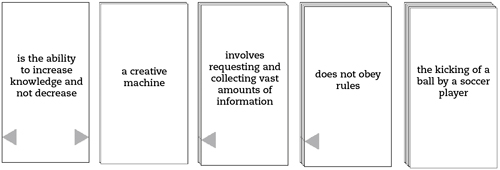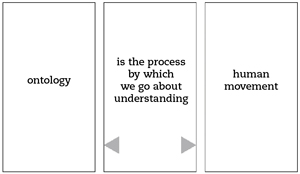I am a game designer. Figment, my contribution to Switching Codes, reflects my disciplinary activity: it is a game for you to play.
The rules and instructions for Figment appear below. Or you may read and print them in a PDF of these instructions. You will also need the PDF of the cards. It is a real game, not a conceptual exercise that flirts with the form of a game or a playful gesture toward something gamelike. The proper way to experience it is to print out the PDF, cut out the cards, read the rules, and sit down with a handful of friends to play. (For those of you suffering from a temporary lack of playmates, there is a solitaire version as well.)
Each of the cards in Figment contains a fragment of text taken verbatim from one of the essays in the book Switching Codes. In playing the game, players combine and recombine these fragments, making statements and declarations that are sometimes profound and sometimes comical. But in each case, a move in the game makes use of raw textual materials from the book, remixing them into novel statements. Playing Figment is thus necessarily an exercise in the playful creation of meaning.
Starting a Game
Shuffle all of the cards and deal each player seven cards, which should be kept hidden from the other players. Place the rest of the cards face-down in a deck.
The goal of the game is to make and modify statements using two or three cards, and to be the first player to get rid of all of the cards in your hand. The youngest player goes first by making a statement, and play continues clockwise around the table.
If the youngest player can’t make a valid statement to start the game, that player draws a card and the player to the left has a chance to start the game, and so on.
Making Statements
You make a statement by placing two or three cards next to each other in the order that they are to be read. There are two kinds of cards: CONCEPT cards, with no arrows on them, and LINKING cards, with one or two arrows. The arrows on the linking cards show how they connect to concept cards. When you make a statement, every arrow on a linking card must point to a concept card. In starting the game, you can make two kinds of statements:

If you use a linking card with two arrows to make a statement, you must use three cards.
Every statement must make grammatical sense; subjects and verbs must agree in number. In addition, a statement must bring some kind of insight to its subject matter. Nonsensical statements (even if grammatically correct) are not permitted.
After you play a statement, you must explain to the other players why the statement is insightful, by reading the new statement and then saying, “Because . . .” Other players can challenge the statements you make. (More on explanations, insight, and challenges below.)
Play
Play continues clockwise around the table. On your turn, you can do one of three things:
- Create a new statement by playing cards from your hand on the table in front of you. Each player can create only one statement per game.
- Modify a statement by playing cards from your hand onto any existing statement.
- Draw a card if there is nothing else you can do.
To CREATE a statement, play two or three cards from your hand to make a completely new statement. This new statement can be modified by other players on subsequent turns. When you make a statement, place the cards on the table in front of you. Each player can create only one statement per game.
To MODIFY a statement, play a card from your hand on top of a previously played card, replacing it in the existing statement. All of the rules for making valid statements hold true when you modify a statement: the modified statement must be grammatically correct, it must be insightful, and you must explain it to the other players.
If you play a linking card to modify and the new card has a different number of arrows than the card you are replacing, you must change the number of concept cards in the statement accordingly:
- If you replace a two-arrow linking card with a one-arrow linking card, you must remove the concept card to the right and put it in a discard pile.
- If you replace a one-arrow linking card with a two-arrow linking card, you must also play a concept card from your hand to complete the statement.
If you DRAW, take the top card from the deck and add it to your hand. You do not get to play any cards if you draw.
Challenges
In addition to being grammatically correct, any created or modified statement must bring insight to its subject matter. Each time a player makes or modifies a statement, the player must read the new or modified statement to the group and then explain, “Because . . .” The explanation should make clear how the statement brings insight to its subject matter. The standard for what is considered insightful will, of course, vary from group to group and context to context.
After the explanation is complete, a player who feels that the statement does not bring insight to its subject matter—because, for example, it is nonsensical, patently false, or simply too conventional—can CHALLENGE the statement. The player who challenges presents an argument as to why the statement should not be permitted to be played, and then the remaining players vote. Challenges should be used sparingly.
If the challenger convinces a majority of the other players (not including the player who made the statement) that the statement is not insightful, the challenge succeeds. Otherwise, the challenge fails.
- If the challenge succeeds, the player who played the challenged statement takes all of the cards played that turn back into his or her hand and restores the modified statement to its previous state. The player also draws one card from the deck, and his or her turn ends.
- If the challenge fails, then the statement stands on the table. The challenger draws one card from the deck and play continues as usual.
The End
The first player to successfully play the last card in his or her hand wins the game.
Figment Solitaire
Because we so often lack playmates, rules are provided for a solitaire version of Figment. It lacks the disputation and social negotiation of the full game, but the core mechanism of remixing the meanings of the essays in this volume remains.
To prepare, deal five cards across in a row, face-up. Deal four cards on top of the first row, starting with the second card from the left, then three cards, starting from the middle card, and so on, so that the cards are arranged as shown:

If you can create a two-card or three-card statement using the five visible cards, take the cards off the piles and arrange them to one side to make the statement. If you can’t make a statement from the visible cards, deal another card on each pile until you have cards that can be made into a statement. Criteria for statements are the same as in the regular game, including grammatical correctness and insight.
Set the rest of the cards aside (you won’t be using them). The goal of Figment Solitaire is to get rid of all of the cards in the piles you dealt by modifying the statement and creating new ones. In the solitaire version of the game, unlike the full version, there is always only one statement visible for you to modify.
To play the game, you can take one of two actions:
- Create a new statement
- Play a single card from the piles to modify the current statement
When you create a new statement, take the cards for the new statement off the dealt piles and play them right on top of the current statement, covering up the old cards.
When you play a card and modify a statement, you can rearrange any of the currently visible cards in the statement. For example, if the current statement is

and you want to modify the statement by playing the concept card “dance steps” from a pile, you could rearrange the visible statement cards like so:

One last clarification: Sometimes, you will be turning a three-card statement into a two-card statement. This happens when you create a two-card statement on top of a three-card statement, or when you replace the two-arrow linking card in a three-card statement with aone-arrow linking card. In these cases, you will be left with a visible card that isn’t part of the current statement. That’s OK. You can decide whether the unused card is the concept card on the left or the right. And on subsequent modifications, you can use any of the three visible cards, not just the two that are being used in the statement.
To win, play the last card from the piles of cards. If you get stuck in a position where you can’t play, you lose. As with other solitaire games, there is some luck involved. However, by playing strategically, using cards from your deeper piles first, keeping an eye on which kinds of cards are visible, and thinking two or three moves ahead, you will greatly increase your chances of winning.
